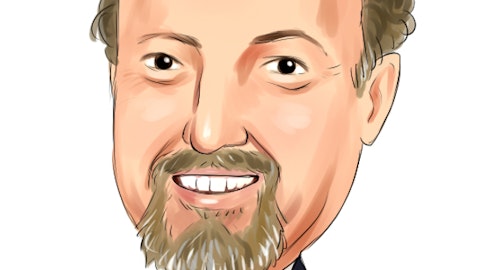Yes. And from an EBITDA point of view, as it’s just one side, it will depend on — it is cumulative depending on new investments in Germany. That’s going to be a question then when will interest change — interest rates change for how long and so on. So the simple answer — the simple answer, it has no impact when it comes to the value of our company.
Iris Eveleigh: And the next question comes from — who is next in line? The next question comes from Alberto from Goldman.
Alberto Gandolfi: I mean, at the suns of — repetitive, Marc, congratulations for big job, can I also Martin Jager for all the help over the years and congratulation him on his fantastic move. And 2 questions on my end. I don’t want to be dismissive about the planning just presented. You managed to make power distribution grades exciting, probably for the first time in the history of the industry. But I was trying to understand what’s next here. So if I think about the balance sheet headroom, there’s €5 million to €10 billion. And I was wondering, Germany is a highly disseminated market. Is there an angle here where you could be a consolidator, maybe of your own minorities or a consolidator of other concessions perhaps even considering an asset swap, whereby you can swap some of the gas grid for the power grid.
Is that something that is on your mind potentially down the line? And the second question, I think if we look at Slide 7, we can clearly see that CapEx starts below €6 billion at €5.7 billion and ends up at €7.5 billion, and Leo, you were talking about this level of growth well into the 2030s. Does it mean that the €7.5 billion is obviously not the maximum you can do and potentially beyond ’28, that €7.5 provided returns are attractive, could actually keep growing?
Leonhard Birnbaum: All right. So Alberto, you don’t sound dismissive to us at all. We have seen the electrification compounder which you put out, which we have taken note of. So we feel actually pretty good with whatever you throw in our direction. So no, actually, you all — I’ve a first comment, you’re all already asking what’s next, yes? I mean, what’s next is first delivery. I mean, it’s €42 billion delivery. It’s €11 billion EBITDA in ’28 delivery. So yes, we are thinking beyond, but we are focusing on our organization first on deliver here and now because every dream pipe otherwise, is worth nothing if we don’t deliver in the next year, the year after next and so on. So — so now I don’t want to sound dismissive, but I just want to remind that a good plan is not automatically executed.
It just needs good work. So nevertheless, to your concentrator question, no, I would not like to speculate around the consolidation that we could actually drive in the market or whatever. But I think there is an even more interesting game to look at. Is there a consolidation of processes and systems because we know the complexity of the future energy world is such that many players will actually struggle to do that internally. And what I would find actually more attractive than anything else is if many companies — smaller players would come to us and say, “Couldn’t you run a number of processes for us, could you take complexity of our back and handle it together with everything you’re handling already.” That would be for us actually more interesting because it will provide obviously a boost — a profitability boost without a further CapEx deployment.
So I think there are different consolidation gains possible than just a straightforward M&A, A, B, whatever asset swap speculation. And that is the even more interesting one, and that is probably one that is really going to come our way. We are already seeing smaller players being overwhelmed by the investment requirements, the complexity of the system, et cetera. So that’s one. And then the €7.5 billion, no, it’s not a max. The 5-year CapEx plans that we have shown over the last year and also the one that we are showing now is a slope, it’s not a continuous, it’s kind of like same number in every year. It’s actually growing year-over-year. So if we roll it forward, it’s actually growing to a certain extent also automatically. And yes, we are going to be clearly above €7.5 billion.
We are clearly going to be above the average in the ’28 planning. So if you look at it year-over-year, you would see it’s an increasing slope.
Iris Eveleigh: So we move on to the next question from James Brand from Deutsche Bank.
James Brand: Sorry. We made it today. So I had a couple of questions. One was actually on delivery, so it feeds in quite nicely from the previous answer. And the question is, what are your biggest challenges and particularly around supply chain because we’ve heard a lot of things around, obviously, supply chain issues and more of the renewable industry than your industry. But is the supply chain where it needs to be for you to deliver what you’re targeting over the next 5 years? And then secondly, on retail I see that your kind of targeting a 3% to 5% energy sales margin. I think that’s increased because I think you used to talk about 2% to 4%, I know there is a little star and a disclosure around how it’s defined, so maybe it’s a definitional issue.
But has that increased? And what are you seeing in terms of competition on Energy Retail because you’ve always been signaling at the 9-month results that the competitive backdrop there had improved? And also for me, sorry, I should say well done on the good results, and congratulations to Marc.
Marc Spieker: Thank you, James. And why don’t I start with the Retail, and you take the delivery. We changed all this time you need to deliver. So Retail, the 3% to 5%, it’s an average portfolio target. And our strategy is clear. We will focus on high-value, high-quality customers, and that is what you’ve seen we’ve been doing already during the last 3, 4 years. So this is not something which we are inventing with this midterm plan. And this is why we will be gradually also increasing the margin level on a portfolio level. And keep in mind that we are driven down significantly our B2B retail exposure, which is strategic noncore and many more measures which we do in order to back this up and where we are comfortable that we will manage this in the current market environment.
Leonhard Birnbaum: Yes. And maybe on the delivery challenges, I think the first challenge is you need to stay focused. So kind of like it never become complacent, whenever you have achieved something think about the next challenge, which is coming. So it’s more — first of all, it’s a mindset issue. You need to be on the ball all the time. I think we are pushing our organization in that direction. I tried to answer the point on the supply chain in my speech. It’s an issue, obviously, if you ramp it up, for example, some suppliers now need to expand their capacity. And for that, they need longer-term visibility on the volumes which we are ordering. So we need to change the approach which we are taking, saying, we will take for the next 5 years, year-over-year this amount, yes, which we have not done in the past, which was not necessary.
So yes, we are changing approach. But overall, we have it under control. Our size is an asset here. And I might repeat what I said, €1.7 billion up, no supply chain shortage. We have good visibility for the critical — I mean, procurement groups, also going forward, so we don’t foresee that. The only supply chain shortage, which we’re right now having is desks in our 4 offices. So actually, it’s a problem we’ll be having. So some people have to wait longer for new desks than they actually anticipated before. But so far, no, we really have it under control. It feels the fact that we have been really focused on all these topics, demographics, supply chain, digitization, process excellence. Year-over-year already now for several years is really paying off.
Iris Eveleigh: With that, we move on to Bartek from SocGen.
Bartlomiej Kubicki: Of course, I will join the congratulation wave. Two things I would like to discuss. One is Sweden and the other one is OpEx. On Sweden, if you can perhaps explain to us why the RAB is up 30% on a year-on-year basis from €4.9 billion to €6.4 billion? And then with the increase in the allowed WACC. Shall we expect a sort of automatic increase in EBITDA in ’24? Or you think there are some offsetting factors in Sweden, which will not trigger an EBITDA increase despite the fact that WACC is higher. So simply, is there any cap on tariffs in Sweden? And then on OpEx, you are talking about employing 13,000 more people until 2028, which will of course, increase your OpEx. And I just wonder whether this will trigger a squeeze on your OpEx outperformance or there are also some offsetting factors. For instance, you will significantly increase your OpEx capitalization rate. So consequently, we will see no impact on EBITDA until ’28 from increasing to OpEx.
Marc Spieker: Yes. Bartek, thank you. And let me start with the question on the RAB in Sweden. As you know, the regulatory system in Sweden is a real rate regime. And that means that the regulated asset base is being inflated annually based on a construction price index and what you essentially see in the numbers that you have mentioned is both the effects of organic investments, and on top the indexation change in a real rate environment. When it comes to OpEx, for us, it’s not so much about, is it not 13? Is it 10? Is it 15? This is part of the delivery mindset that Leo has mentioned for us is all about productivity. So we manage is that our cost base manages meaningfully under proportionately than our asset base growth. That’s the ultimate target.
And digitalization is one of the key levers to that. But of course, if you look at the magnitude of the program which is out there, it’s just impossible to do this just with digitalization. It’s impossible. And so we will be adding these people. And yes, we will constantly be looking at opportunities over time, and this includes then also the regulatory period from ’20 onwards, how at any given point in time, we can become more efficient to further outperform against our benchmark cost base.
Leonhard Birnbaum: But if I may. So all we are seeing is already in the plan. The OpEx performance should remain broadly constant, and whatever we are hiring should be somehow be offset by the efficiencies inflation production mechanisms.
Bartlomiej Kubicki: Okay. And on the WACC thing in Sweden, shall we expect an automatic increase in EBITDA in ’24 because of the WACC increase? Or there are some offsetting factors, which are…
Marc Spieker: No, there is — yes, sorry, you asked that. There is no automatism, so it is on to each individual deals or to set the tariffs essentially at their discretion. And with that it doesn’t follow kind of an industry-wide and regulatory-induced tariff cap, it’s a specific decision.





